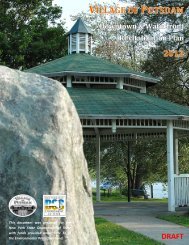Source - Vi.potsdam.ny.us - Potsdam
Source - Vi.potsdam.ny.us - Potsdam
Source - Vi.potsdam.ny.us - Potsdam
You also want an ePaper? Increase the reach of your titles
YUMPU automatically turns print PDFs into web optimized ePapers that Google loves.
<strong>Potsdam</strong> Municipal Airport - Master Plan – Phase 1 Report<br />
TABLE 4-4<br />
AIRPORT DESIGN STANDARDS<br />
(ARC B-II WITH NOT LOWER THAN ¾ MILE VISIBILITY MINIMUMS)<br />
Dimensions<br />
Design Criteria: Standard Existing<br />
Runway Width<br />
Runway Centerline to<br />
- Taxiway Centerline<br />
75'<br />
240'<br />
60’<br />
400’<br />
- Aircraft Parking Area 250' 500’<br />
Taxiway Width 35' 25’<br />
Taxiway Safety Area Width 79' 79’<br />
Taxiway Object Free Area Width 131' 131’<br />
Runway Safety Area<br />
- Width<br />
- Length (beyond runway end)<br />
Runway Object Free Area<br />
- Width<br />
- Length (beyond runway end)<br />
150'<br />
300'<br />
500'<br />
300'<br />
150’<br />
300’<br />
500’<br />
300’<br />
<strong>Source</strong>: FAA Advisory Circular 150/5300-13 (incorporating Changes 1-11, March 28, 2007) and C&S Engineers, Inc.<br />
4.02-2 Runway Orientation<br />
The orientation of runways for takeoff and landing operations is primarily a function<br />
of wind velocity and direction, together with the ability of aircraft to operate under<br />
adverse conditions. As a general rule, the primary runway at an airport is oriented as<br />
closely as practicable in the direction of the prevailing winds. The most desirable<br />
runway configuration will provide the largest wind coverage for a given maximum<br />
crosswind component. The crosswind component is the vector of wind velocity and<br />
direction which acts at a right angle to the runway. Further, runway wind coverage is<br />
that percent of time in which operations can safely occur beca<strong>us</strong>e of acceptable<br />
crosswind components. The desirable wind coverage criterion for a runway system<br />
has been set by the FAA at 95 percent for a<strong>ny</strong> aircraft forecasted to <strong>us</strong>e the Airport on<br />
a regular basis.<br />
All-weather, VFR, and IFR wind roses were developed for <strong>Potsdam</strong> Municipal<br />
Airport <strong>us</strong>ing information gathered from the weather observations taken over a 10-<br />
year period from 1997 to 2006 at Massena International Airport. As shown on the<br />
wind roses depicted on Figure 4-1, Runway 6-24 provides an all-weather wind<br />
coverage of 99.83% for a 16 knot crosswind, 98.93% for a 13 knot crosswind, and<br />
97.28% for a 10.5 knot crosswind. The figures exceed the FAA's recommended 95%<br />
wind coverage and provide acceptable coverage for the smallest aircraft 97.28% of<br />
the time.<br />
4-6



